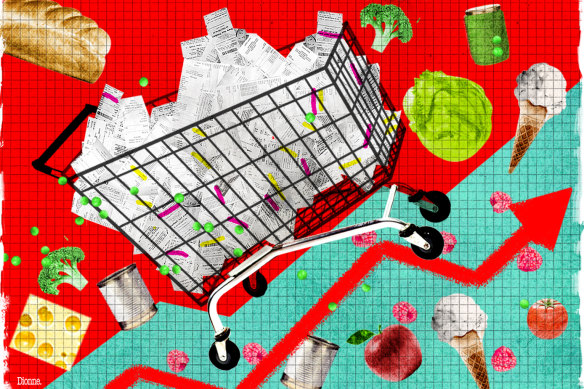This was published 1 year ago
Opinion
Sixteen ways to slash your grocery bill and beat rising prices
Jessica Irvine
Senior economics writerIn late 2020, opportunities for more enjoyable social outings severely curtailed by COVID-19, I decided to conduct a thorough supermarket analysis of the price of a basket of goods at Coles versus Aldi.
To give Coles the benefit of the doubt, I analysed all Aldi brands against the lowest-cost Coles home brand product, or the nearest equivalent.

You’re not just imagining it. The price of just about everything is rising. So what can you do?Credit: Dionne Gain
Even so, Aldi worked out to be 11 per cent cheaper across the 40 items purchased, making it the clear winner. Recently, I decided to revisit the results of my survey to see how prices have changed.
The answer? A lot.
Aldi doesn’t display their prices online, but I was able to compare Coles prices online, which revealed several disturbing findings. For instance, the two-litre tub of Coles vanilla ice cream I purchased for $2.75 in 2020 now costs $4.50. The 2 litres of lite milk I purchased for $2.39 has increased to $3.10.
In what can only be described as an assault on the Australian way of life, the 1.8kg tray of basic beef sausages I purchased for $9 in 2020 now costs $12. A frozen Hawaiian pizza is $5, up from $3.30.
Fruit prices are highly seasonal, of course, but a full head of cauliflower now costs $4.90, up from $3.90. Bananas are about $4 a kilo, up from $2.50.
Non-edible items have also shot up in price: the cost of a 4-pack of Dove soap climbing from less than $5 to $7.50.
So, no - you’re not just imagining it. The price of just about everything is rising. So what can you do?
Here are 16 simple tips to help you get on top of rising food bills.
Diversify your supermarket portfolio
What works for your investment portfolio works just as well for your food shopping. Foreign competitor chains like Aldi and Costco are definitely cheaper overall, but they might not have everything you want.
Switching between stores and savvy shopping of their weekly specials can help to minimise costs.
Check for discounts
Sign up for their weekly emails or check apps like Half Price, Wiselist and frugl to stay informed of specials. Bulk buy products you use regularly when they are on sale.
Use loyalty programs
Both Coles and Woolworths have upped their loyalty game in recent times. Woolworths now has a $59 per year ‘Everyday Extra’ program that entitles you to 10 per cent off one shop per month (plus 10 per cent off at Big W once per month). I have found this more than pays for itself. Coles also has special discounts for members of its Flybuys program, which applies both in store and online.
Shop online
Ordering groceries online is not only a great way to save time, but also avoid the temptation of buying things you don’t need. You can instantly see your total spend and quickly eject items from your basket if you realise you are going over budget.
Shop by unit price
Shopping online also enables you to sort search results by ‘unit price’ – which is the price of items displayed per kilogram or per litre or other units of measurement.
The introduction of unit pricing on store labels was a hard-won victory for consumer groups about two decades ago. So use it to compare like for like!
Switch to home brands
Home brands usually emerge as the cheapest option on any price comparison. Sure you might be used to your other brands, but why not at least give the home brands a try to see if you can detect any major difference in quality? We are blessed with good quality home-branded foods in this country, so enjoy them.
Buy tinned food
Tinned food is not only cheaper, but it also lasts longer, meaning it is less likely to go to waste. If you are looking for salmon to add to your salads or other dishes, Coles tinned salmon costs from just $14.74 per kilogram, compared to fresh salmon which starts at $46.76 per kilogram.
Buy low-processed food
The golden rule of food shopping is to buy ingredients as close to their natural state as possible. Once things have sauces added, or are sliced and diced in different ways, you know you are paying extra.
Buy frozen food
Frozen chopped spinach costs $4 per kilo versus $14.50 per kilogram for a bag of spinach. Frozen blueberries cost $12.40 per kilogram, versus $36 per kilogram for fresh blueberries. Same nutrients, very different price.
Look out for discount meats
The meat sections of major supermarkets will often have a part down one end where items approaching their expiry states are put and heavily discounted. Harris Farm is particularly good for this. So keep an eye out!
Freeze meats immediately
In my former life, I was often guilty of letting meat go off before I could cook it. These days I avoid any such budgetary and moral guilt by immediately opening trays of meat, breaking them into smaller portions and freezing them immediately for later use. You’ll thank me later.
Know the difference between “use by” and “best before”
Food manufacturers use “use by” dates to denote the date after which it’s not deemed safe to still consume an item. A “best before” date means it’s possible the quality of the item may have declined. So give “best before” a sniff test rather than chucking them straight out.

Supermarket loyalty schemes are popular among shoppers.Credit: James Alcock/Getty
Shop your pantry first
Mum was right – you do have food at home. Use it. Apps like the SuperCook recipe app let you punch in the items you have to hand for a tasty recipe to try.
Banish your salad drawer
I’ve removed the salad drawer – aka vegetable graveyard – from my fridge altogether and keep all my fresh fruit and veg that needs to be eaten soon on the top shelf where it is most visible.
Meal prep
When cooking, always make more than you need for one meal and freeze for later lunches or quick meals when you are pushed for time. Yes, it takes a bit of time, but it’s cheaper than buying food on the go.
Keep pre-prepared meals on hand
Don’t try to be too pure with your shopping. Keep some of those $5 frozen pizzas on hand for the nights when life just gets in the way. If it saves you from reaching for the Dominos or UberEats app, that’s a win.
- Advice given in this article is general in nature and is not intended to influence readers’ decisions about investing or financial products. They should always seek their own professional advice that takes into account their own personal circumstances before making any financial decisions.
Jessica Irvine is author of Money with Jess: Your Ultimate Guide to Household Budgeting. You can follow more of Jess’ money adventures on Instagram @moneywithjess and sign up to receive her weekly email newsletter.